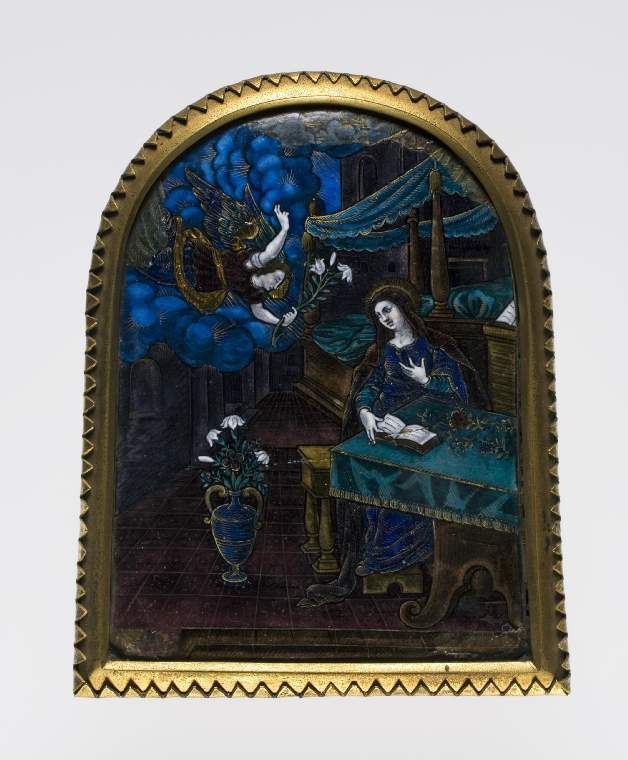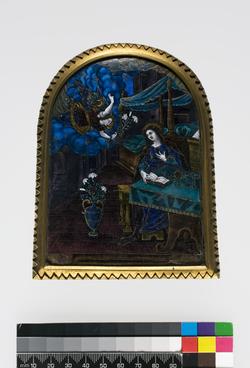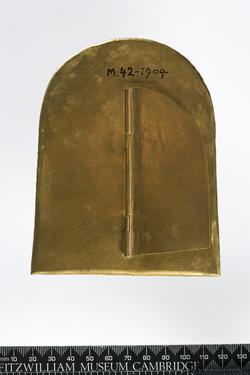Current Location: In storage
Titles
The Annunciation
Maker(s)
Enameller:
Limosin, Jean
Entities
Categories
Description
Copper plaque decorated with polychrome enamels, silver foils, and gilding. The Virgin is seated at a table on the right with a canopied bed in the background, and a vase of lilies in the foreground. The Archangel Gabriel holding a stem of lilies swoops down in from the left. Gilt-metal frame
Rectangular, slightly convex copper plaque with arched top, enamelled over a white preparation or silver (probably) foils in translucent blue, turquoise, yellow, pale red, dark red, mulberry, purple, and brown, and in black, and white, and gilded. The Virgin’s garments and those of the Archangel and his wings, the vase, the flowers in it and those lying on the table are foiled. The outlines are drawn in black on the white preparation or on the foils. The flesh is tinted by a thin wash of pink with clusters of fine pale red lines. The counter-enamel is concealed by the frame. The Virgin is seated on a yellow bench with her feet on a footstool beside a brown table covered by a turquoise cloth on which lie an open book, and scattered flowers. She wears a dark red mantle over a blue dress with turquoise sleeves. She holds open the book with her right hand and has raised her left to her breast. Behind her there is a brown four-poster bed with turquoise valance and cover. A blue two-handled vase containing four lilies, a purple four-petalled flower,two small blue flowers, and a turquoise flower, stands to the left on the purple tiled floor, which has two brown edged steps in the foreground. The Archangel Gabriel swoops down from turquoise clouds on the left. His right arm is raised in salutation, and he holds a stem with three lilies in his left hand. He has blue and turquoise wings and wears a crimson tunic over a blue gown with a yellow sash. Below is a wall with an arched window and a door, and in the distance beyond the bed, a building with a doorway and window, all in purple. Gold is used to define the edges of the furniture, table cover, and bed hangings, the vase and its handles, the stylized floral and other motifs on the tiles, the edges and shading on the Virgin’s dress and halo, Gabriel’s wings and sash, and the rays of light on the clouds. The plaque is mounted in a arched rectangular gilt metal frame with toothed outer frame on the front, and closed back with a vertically hinged support.
Notes
History note: Hollingworth Magniac (1867-1867), Colworth, Bedfordshire; his son, Charles Magniac (1827-91); sold Christie’s, 2,4-8 and 11-15 July 1892, Catalogue of the renowned collection of works of art chiefly formed by the late Hollingworth Magniac Esq. (known as the Colworth Collection), 5th Day, 7 July, p. 138, lot 519A, sold for £64.1.0 to Frank McClean, MA, FRS (1837-1904), Rusthall House, near Tunbridge Wells.
Legal notes
Frank McClean Bequest
Measurements and weight
Height: 12.9 cm
Width: 9.9 cm
Acquisition and important dates
Method of acquisition: Bequeathed
(1904)
by
McClean, Frank
Dating
17th Century, Early
Henry IV (1553-1610)
Louis XIII (1610-43)
Circa
1605
CE
-
1625
CE
Note
The Annunciation is described in St Luke's Gospel, verses 26-28. The Angel Gabriel visits the Virgin Mary to tell her that she has found favour with God, and will bear a son, who will be named Jesus. The lilies in Gabriel's hand, and in the vase beside the Virgin, are symbols of her purity. The overall design and details have features in common with several prints of the Annunciation by Jan Sadeler (1500-1600), Justus Sadler (1572/83-1620), and Johannes Wierix (1549-1620). The dark, rich colouring of the enamels, partly applied over silver paillons (small pieces of leaf silver) is typical of Limoges enamels at the end of the sixteenth and during the early seventeenth century. A rectangular Annunciation attributed to Jean Limosin, and having closely comparable figures of the Angel Gabriel and the Virgin, but with a more detailed background, was on the market in Antwerp in 2024 (see Documentation).
On accession by the Fitzwilliam the plaque was unattributed. In 1911, the French scholar, Marquet de Vasselot considered that it was by Suzanne Court c. 1600, but O.M. Dalton in his Catalogue of the McClean Collection (1912) described it as in the style of Jean Limosin (c. 1580-5–1646), and that attribution is upheld here. The Virgin's facial characteristics are very different from those of Suzanne Court's charming female figures, the tiles in the paved floor have a pattern which appears on other enamels attributed to Jean Limosin, but differs from those in Suzanne Court's enamels, and the splayed fingers of the Virgin's hand is a characteristic of other figures by Jean Limosin, such Esther on a large dish in the Louvre decorated with Esther and Ahasurus and signed ‘JEHAN/LIMOSIN’. This was a feature of representations of the Virgin in many prints of the time, and could therefore have been copied by other enamellers, but it does seem to be prominent in the work of Jean Limosin.
Jean or Jehan Limosin was a son of François I Limosin. He was not mentioned in the Limoges role for the taille (a tax) in 1602, and was therefore probably not yet adult, suggesting a date around 1580-5 for his birth. His earliest recorded work, dated 1605, is an oval plaque of the Annunciation signed ‘I. LIMOSIN’, in the Walters Art Museum at Baltimore. Documents in the archives of the department of Haute-Vienne at Limoges dated in 1621, 1623 and 1627 referred to him as enameller to the King which explains his use of a fleur-de-lys between his initials. He was still working in 1635 when he was described as ‘esmailleur’ in the roll for the taille. His will, made in 1631 with a codicil made on his death bed on 3 May 1646, indicated that he was more wealthy than most enamellers, and had agricultural and commercial interests apart from enamelling. He had a brother Joseph, who was also an enameller.
School or Style
Renaissance
People, subjects and objects depicted
Components of the work
Decoration
composed of
enamels
( translucent blue, turquoise, yellow, pale red, dark red, mulberry, purple, and brown, and in opaqueblack, and white)
silver foil
gold
Materials used in production
Copper
References and bibliographic entries
-
Catalogue of the Renowned Collection of Works of Art, chiefly formed by the late Hollingworth Magniac, Esq. (Known as the Colworth Collection)
page(s): 138
-
Fitzwilliam Museum, McClean Bequest, Catalogue of the Mediaeval Ivories, Enamels, Jewellery, Gems and Miscellaneous Objects Bequeathed to the Museum by Frank McClean, M.A., F.R.S.
page(s): 114
-
The Walters Art Gallery, Catalogue of the Painted Enamels of the Renaissance
page(s): 338-40
-
Limoges and other painted Enamels
page(s): 386-7
-
Les émaux peints de Limoges. Musée du Louvre, Département des objets d'art
-
Le métier d’émailleur à Limoges, XVIe-XVIIe siècle
-
Sedes Sapientae, A Selection from my Most Recent Acquisitions, Catalogue 24
page(s): 60-1
Identification numbers
Accession number: M.42-1904
Primary reference Number: 156428
Stable URI
Audit data
Created: Saturday 6 August 2011
Updated: Wednesday 20 March 2024
Last processed: Thursday 14 August 2025
Associated departments & institutions
Owner or interested party:
The Fitzwilliam Museum
Associated department:
Applied Arts

 IIIF Manifest
IIIF Manifest






